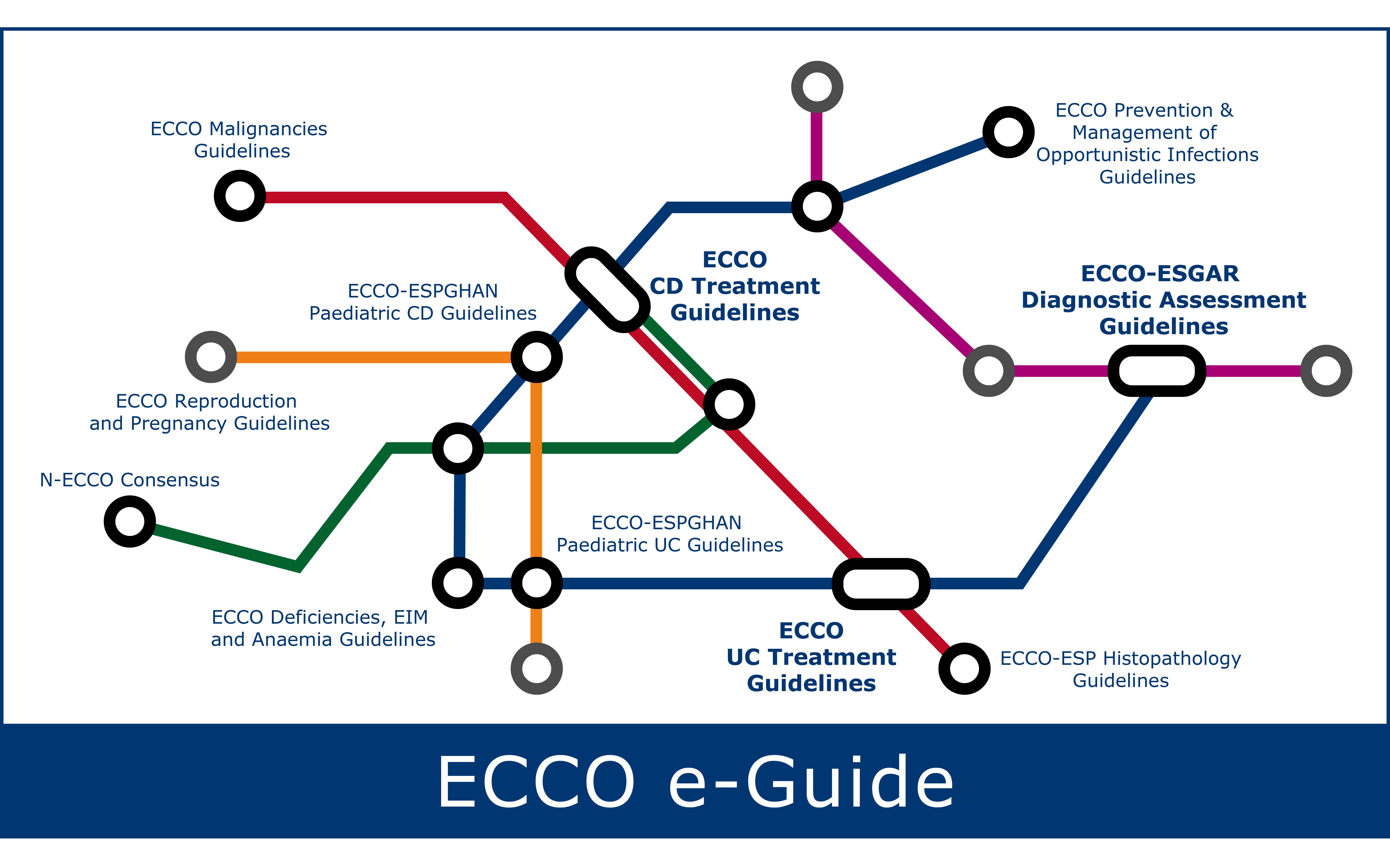The information below is based on the summary of product characteristics approved by regulatory authorities. For full details from the SmPC, please click here:
The IV induction dose: https://www.medicines.org.uk/emc/product/4412/smpc
The maintenance subcutaneous dose: https://www.medicines.org.uk/emc/product/4413/smpc
Additional related ECCO e-Learning resources can be found under IBD Curriculum Topic 6.1-6.11
Introduction and Mechanism of Action:
- IV induction infusion: each vial contains 130 mg ustekinumab in 26 mL (5 mg/mL).
- 90 mg solution for injection: each vial contains 90 mg ustekinumab in 1 mL.
- 90 mg solution for injection in pre-filled syringe: each pre-filled syringe contains 90 mg ustekinumab in 1 mL
Ustekinumab is a fully human IgG1κ monoclonal antibody that binds with specificity to the shared p40 protein subunit of human cytokines interleukin (IL)-12 and IL-23. Ustekinumab inhibits the bioactivity of human IL-12 and IL-23 by preventing p40 from binding to the IL-12Rβ1 receptor protein expressed on the surface of immune cells. Ustekinumab cannot bind to IL-12 or IL-23 that is already bound to IL-12Rβ1 cell surface receptors. Thus, ustekinumab is not likely to contribute to complement- or antibody-mediated cytotoxicity of cells with IL-12 and/or IL-23 receptors. IL-12 and IL-23 are heterodimeric cytokines secreted by activated antigen presenting cells, such as macrophages and dendritic cells, and both cytokines participate in immune functions; IL-12 stimulates natural killer (NK) cells and drives the differentiation of CD4+ T cells toward the T helper 1 (Th1) phenotype, IL-23 induces the T helper 17 (Th17) pathway. However, abnormal regulation of IL 12 and IL 23 has been associated with immune mediated diseases, such as psoriasis, psoriatic arthritis and Crohn's disease.
Therapeutic indications
Ulcerative colitis: Currently not licensed (approval expected toward the end of 2019)
Crohn's disease: Ustekinumab is indicated for the treatment of adult patients with moderately to severely active Crohn's disease who have had an inadequate response with, lost response to, or were intolerant to either conventional therapy or a TNFα antagonist or have medical contraindications to such therapies
Dosing, administration
Ulcearive colitis: Currently not licensed (approval expected toward the end of 2019)
Crohn's disease: Ustekinumab treatment is to be initiated with a single intravenous dose based on body weight. The infusion solution is to be composed of the number of vials of ustekinumab 130 mg as specified in the table below.
Initial intravenous dosing of ustekinumab
|
Body weight of patient at the time of dosing |
Recommended dosea |
Number of 130 mg ustekinumab Vials |
|
≤ 55 kg |
260 mg |
2 |
|
> 55 kg to ≤ 85 kg |
390 mg |
3 |
|
> 85 kg |
520 mg |
4 |
a Approximately 6 mg/kg
The first subcutaneous administration of 90 mg ustekinumab should take place at week 8 after the intravenous dose. After this, dosing every 12 weeks is recommended. Patients who have not shown adequate response at 8 weeks after the first subcutaneous dose, may receive a second subcutaneous dose at this time. Patients who lose response on dosing every 12 weeks may benefit from an increase in dosing frequency to every 8 weeks. Patients may subsequently be dosed every 8 weeks or every 12 weeks according to clinical judgment. Consideration should be given to discontinuing treatment in patients who show no evidence of therapeutic benefit by week 16 or 16 weeks after switching to the 8-weekly dose.
Immunomodulators and/or corticosteroids may be continued during treatment with ustekinumab. In patients who have responded to ustekinumab treatment, corticosteroids may be reduced or discontinued in accordance with standard of care.
If therapy is interrupted, resumption of treatment with subcutaneous dosing every 8 weeks is safe and effective.
Contraindications
Hypersensitivity to the active substance or to any of the excipients listed in section 6.1 of full SmPC.
Clinically important, active infection (e.g. active tuberculosis; see section 4.4 of full SmPC).
Adverse effects
The most common adverse reactions (> 5%) in controlled periods of the adult psoriasis, psoriatic arthritis and Crohn's disease clinical studies with ustekinumab were nasopharyngitis and headache. Most were considered to be mild and did not necessitate discontinuation of study treatment. The most serious adverse reaction that has been reported is serious hypersensitivity reactions including anaphylaxis. The overall safety profile was similar for patients with psoriasis, psoriatic arthritis and Crohn's disease. No new safety concerns were identified with up to 2 years of treatment in patients with Crohn's disease.
Infections
Ustekinumab may have the potential to increase the risk of infections and reactivate latent infections. In clinical studies, serious bacterial, fungal, and viral infections have been observed. Caution should be exercised when considering use in patients with a chronic infection or a history of recurrent infection. Prior to initiating treatment patients should be evaluated for tuberculosis infection as ustekinumab must not be given to patients with active tuberculosis. Treatment of latent tuberculosis infection should be initiated prior to administering ustekinumab. Patients receiving ustekinumab should be monitored closely for signs and symptoms of active tuberculosis during and after treatment. Patients should be instructed to seek medical advice if signs or symptoms suggestive of an infection occur. If a patient develops a serious infection, the patient should be closely monitored and ustekinumab should not be administered until the infection resolves.
Malignancies
Immunosuppressants like ustekinumab have the potential to increase the risk of malignancy. Some patients who received drug in clinical studies developed cutaneous and non-cutaneous malignancies. No studies have been conducted that include patients with a history of malignancy or that continue treatment in patients who develop malignancy while receiving ustekinumab. Thus, caution should be exercised when considering the use in these patients.
All patients, in particular those greater than 60 years of age, patients with a medical history of prolonged immunosuppressant therapy or those with a history of PUVA treatment, should be monitored for the appearance of non-melanoma skin cancer.
Systemic and respiratory hypersensitivity reactions
Serious hypersensitivity reactions have been reported in the post-marketing setting, in some cases several days after treatment. Anaphylaxis and angioedema have occurred. If an anaphylactic or other serious hypersensitivity reaction occurs, appropriate therapy should be instituted and administration of ustekinumab should be discontinued.
Cases of allergic alveolitis and eosinophilic pneumonia have been reported during post-approval use of ustekinumab. Clinical presentations included cough, dyspnoea, and interstitial infiltrates following one to three doses. Serious outcomes have included respiratory failure and prolonged hospitalisation. Improvement has been reported after discontinuation of ustekinumab and also, in some cases, administration of corticosteroids. If infection has been excluded and diagnosis is confirmed, discontinue ustekinumab and institute appropriate treatment.
The needle cover on the syringe in the ustekinumab pre-filled syringe is manufactured from dry natural rubber (a derivative of latex), which may cause allergic reactions in individuals sensitive to latex
Vaccinations
It is recommended that live viral or live bacterial vaccines (such as Bacillus of Calmette and Guérin (BCG)) should not be given concurrently with ustekinumab. Specific studies have not been conducted in patients who had recently received live viral or live bacterial vaccines. No data are available on the secondary transmission of infection by live vaccines in patients receiving Ustekinumab. Before live viral or live bacterial vaccination, treatment with ustekinumab should be withheld for at least 15 weeks after the last dose and can be resumed at least 2 weeks after vaccination. Prescribers should consult the Summary of Product Characteristics for the specific vaccine for additional information and guidance on concomitant use of immunosuppressive agents post-vaccination.
Patients receiving ustekinumab may receive concurrent inactivated or non-live vaccinations.
Long term treatment with ustekinumab does not suppress the humoral immune response to pneumococcal polysaccharide or tetanus vaccines.
Concomitant immunosuppressive therapy
In psoriasis studies, the safety and efficacy of ustekinumab in combination with immunosuppressants, including biologics, or phototherapy have not been evaluated. In psoriatic arthritis studies, concomitant methotrexate (MTX) use did not appear to influence safety or efficacy. Likewise, in Crohn's disease studies, concomitant use of immunosuppressants or corticosteroids did not appear to influence safety or efficacy.
Immunotherapy
Ustekinumab has not been evaluated in patients who have undergone allergy immunotherapy. It is not known whether it may affect allergy immunotherapy.
Serious skin conditions
In patients with psoriasis, exfoliative dermatitis has been reported following ustekinumab treatment. Patients with plaque psoriasis may develop erythrodermic psoriasis, with symptoms that may be clinically indistinguishable from exfoliative dermatitis, as part of the natural course of their disease. As part of the monitoring of the patient's psoriasis, physicians should be alert for symptoms of erythrodermic psoriasis or exfoliative dermatitis. If these symptoms occur, appropriate therapy should be instituted. Ustekinumab should be discontinued if a drug reaction is suspected.
Special populations
Elderly (≥ 65 years)
No overall differences in efficacy or safety in patients age 65 and older who received ustekinumab were observed compared to younger patients, however the number of patients aged 65 and older is not sufficient to determine whether they respond differently from younger patients. Because there is a higher incidence of infections in the elderly population in general, caution should be used in treating the elderly.
Laboratory parameters and monitoring
Monitoring should be undertaken as per local and national guidelines
Interactions with other Drugs
Live vaccines should not be given concurrently.
No drug interaction studies have been performed in humans. In the population pharmacokinetic analyses of the phase III studies, the effect of the most frequently used concomitant medicinal products in patients with psoriasis (including paracetamol, ibuprofen, acetylsalicylic acid, metformin, atorvastatin, levothyroxine) on pharmacokinetics of ustekinumab was explored. There were no indications of an interaction with these concomitantly administered medicinal products. The basis for this analysis was that at least 100 patients (> 5% of the studied population) were treated concomitantly with these medicinal products for at least 90% of the study period. The pharmacokinetics of ustekinumab was not impacted by concomitant use of MTX, NSAIDs, 6-mercaptopurine, azathioprine and oral corticosteroids, or prior exposure to anti-TNFα agents, in patients with psoriatic arthritis or Crohn's disease. The results of an in vitro study do not suggest the need for dose adjustments in patients who are receiving concomitant CYP450 substrates.
Special situations (e.g. pregnancy)
Women of childbearing potential
Women of childbearing potential should use effective methods of contraception during treatment and for at least 15 weeks after treatment.
Pregnancy
There are no adequate data from the use of ustekinumab in pregnant women. Animal studies do not indicate direct or indirect harmful effects with respect to pregnancy, embryonic/foetal development, parturition or postnatal development.
Breast-feeding
It is unknown whether ustekinumab is excreted in human breast milk. Animal studies have shown excretion of ustekinumab at low levels in breast milk. It is not known if ustekinumab is absorbed systemically after ingestion. Because of the potential for adverse reactions in nursing infants from ustekinumab, a decision on whether to discontinue breast-feeding during treatment and up to 15 weeks after treatment or to discontinue therapy must be made taking into account the benefit of breast-feeding to the child and the benefit of ustekinumab therapy to the woman.
Fertility
The effect of ustekinumab on human fertility has not been evaluated.

